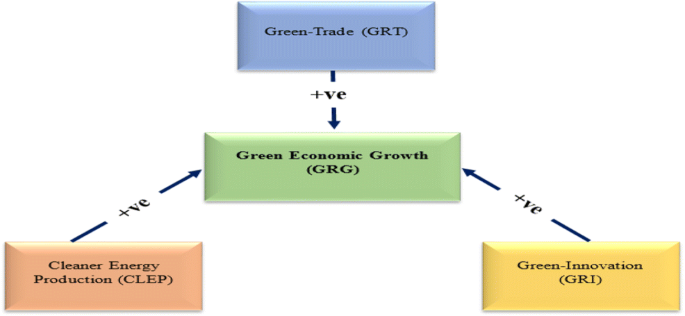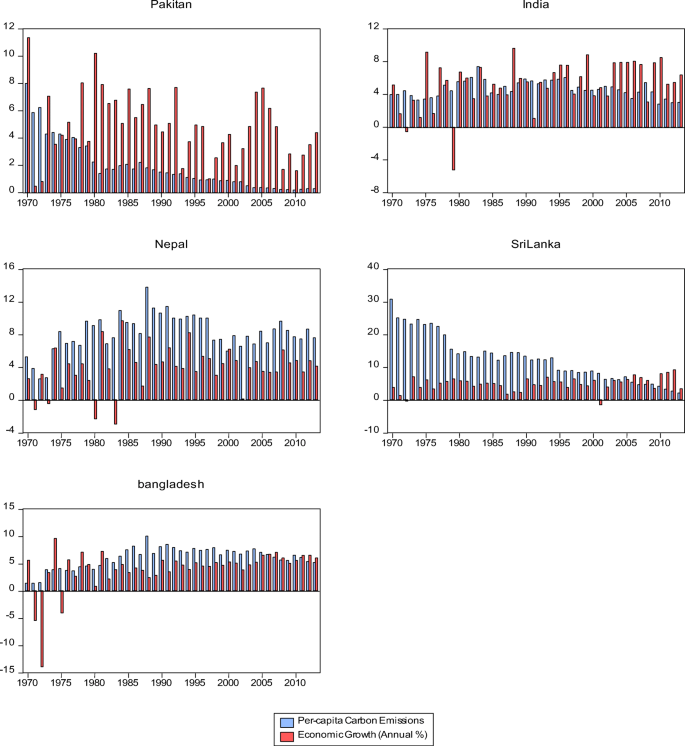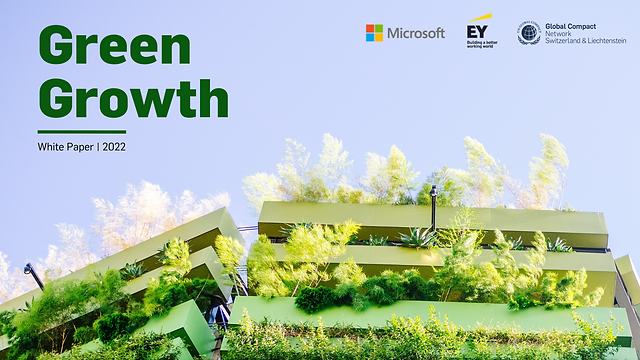Green innovation
Courtesy : link.springer.com/
The objective of this study is to contribute to the existing debate of green economic growth by empirically investigating the role of cleaner energy production, green innovation, and green trade in green economic growth in the context of South Asian countries. For this purpose, the study collects the data of South Asian Economies for 2000–2018 from different sources such as world development indicators (WDI), International Energy Statistics (IES), and Organization for Economic Co-operation and Development (OECD) statistics. The study applied Pesaran’s (2007) second-generation unit root test to test the stationarity of the data. Wasteland’s (2007) test of cointegration was applied to examine the long-run association among modeled variables. The study confirmed the long-run association among modeled variables that turn to be stationary at the first differences. Moreover, the study applied fully modified least square (FMOLS) and dynamic least square (DOLS) to estimate the empirical results of the study. Results of the study show that the production of clean energy, green innovation, and green trade positively contributes to the green economic growth of South Asian Economies

Introduction
Various studies have revealed that the present level of economic growth is not sustainable as it results serious environmental problems in the form of climate change, air pollution, contaminated water, and loss of biodiversity (IPCC, 2014). In the expanse of these environmental challenges, governments have started to search for an appropriate approach to sustainable economic progress. Furthermore, periodic failures in international policies made it necessary to explore a new paradigm of growth. Thus, the global discussion for sustained economic growth has been started. United Nations Economic and Social Commission for Asia and the Pacific (UNESCAP) indicated that environmental sustainability is essential to achieve the sustained economic path. Thus, a new paradigm of growth, known as “green economic growth” has been introduced. Green economic growth is an extension of the economic growth model which advances economic progress through environmental protection and social sustainability (Bagheri et al. 2018; A. A. Syed et al. 2021; Yang et al. 2019). Implementation of green economic growth in the economy can open up new sources of growth through improved productivity and macroeconomic stability. It also protects the environment, promotes social progress, and minimizes the risk to growth that arises due to a shortage of resources (Indicators 2011; A. Syed and Tripathi 2018).
Existing sustainable development goals (SDGs) shows that environmental sustainability (SDG 13), employment opportunities and economic growth (SDG 8), clean water and sanitation (SDG 6), healthiness and well-being (SDG 3), and responsible production and consumption (SDG12) are most challenging issues for developing nations (Baumeister 2018; Sinha et al. 2018) which can be solved with the implementation of green economic growth policies. Therefore, it is believed that green economic growth is critical for the achievement of sustainable development goals (SDGs). It is also a credible approach to energy efficiency and climate change mitigation (Yusof et al. 2016) and a widely recognized solution to environmental problems (Sandberg et al. 2019). Researchers identify the presence of green economic growth in history, but the disclosure of green economic growth (as another term for sustainable development) is still limited to the theoretical perspectives. Hence, there is a need for the implementation of green economic growth policies to overcome environmental disputes and for the achievement of SDGs. The present study proposes that Cleaner energy production, Green Innovation, and Green Trade are the important determinants of green economic growth as they significantly contribute to economic progress and environmental sustainability.
Green energy is one of the most important factors that significantly contribute to green economic growth. The present study claims that green energy promotes green economic growth. Numerous researchers regarded green energy as an environmentally friendly source of energy that reduces carbon emissions and argued that the production of green energy is an optimal choice of ensuring environmental protection as it reduces the dependency on inadequate resources such as gas, coal, and fuel (Alper and Oguz 2016). Most importantly, substituting the consumption of fossil fuel with renewable energy can significantly reduce the negative externalities from the production process and thus, promotes sustainable economic progress (Alper and Oguz 2016; Owusu and Asumadu-Sarkodie 2016; Sbia et al. 2014). Owusu and Asumadu-Sarkodie (2016) indicated that green energy enhances sustainable economic growth because it detaches economic growth from the deterioration of natural resources. Several empirical studies have found that green energy positively contributes to economic progress and environmental sustainability (Pao and Fu 2013). Some official obligatory contracts such as Kyoto Agreement also encourage the production and consumption of green energy as it reduces carbon emissions.
Besides green energy, green innovation is also a key driver for promoting green economic growth. green innovation not only promotes affordable and environmentally friendly technologies but also reduces the cost of environmental sustainability (Popp 2012). Green innovation reduces environmental pollution by providing the access to modern types of machinery which ultimately promotes economic progress (Yin et al., 2015). The empirical work of Grossman and Krueger (1995) revealed the inverted U shape relation between economic growth and environmental pollution. Similarly, the Environmental Kuznets curve (EKC) indicated the positive association between environmental degradation and economic progress (Munasinghe 1999; Shahbaz et al. 2013). However, this relationship can be revisited by introducing green innovation which is inclined toward green economic growth. It advances the progress of green technologies which can observe, and reduce the patterns of carbon emissions. Green innovation can achieve the target of reducing greenhouse gas (GHG) emissions, improving energy efficiency, and environmental protection. Kaygusuz et al. (2007) indicated that green innovations result in the improvement of the energy sector which ultimately promotes economic progress. Furthermore, it is believed that real sustainable economic progress is not possible without green innovations (Abbas et al. 2020; Lorek and Spangenberg 2014). Referring to this fact, the present study incorporates green innovations in explaining long-term green economic growth.
The present study strongly argues that green trade is another important determinant of green economic growth as it provides the access to economical goods and services which accelerate the shift into the green economy. Green trade enhances green economic growth by reducing GHG emissions, improving energy efficiency, advancing industrial activities, and promoting economic progress. The literature revealed that green trade can alleviate environmental disputes, promote social sustainability, and promote economic progress by proving the assessment of environmental goods (Dahal and Pandey 2018). Thus, the author perceived green trade as an essential element that can advance the green economic growth of nations.
The aforementioned discussions motivated the researcher to examine the role of green energy, green innovation, and green trade in the green economic growth of South Asian Nations. The present study focuses on South Asian Economies due to many reasons: First, South Asia is one of the most susceptible regions with the most damaging effects of climate change which can be mitigated with the promotion of green economic growth. The region is expected to experience warming of 2–6 °C by the end of the 21st century (Ravindranath 2007). Currently, the South Asian countries share 7% of global GHG releases, which increased gradually from 1970 to 2016. All the member nations of the region show the same pattern (Shown in Fig. 1).

Second, the region is experiencing a rapid increase in its economic growth. During the entire period of 2005–2010, regional GDP increased by the mean of 7.9% per annum and per capital Real GDP in purchasing power parity (PPP, at constant 2005 international $) increased at a compounded annual growth rate of 8.45%. However, the current approach of economic growth is not appropriate as it deteriorates the environment of the region in many ways; an incredible increase in carbon emissions is one of the most prominent. This rapid increase in economic growth results in increased demand for energy which tends to increase the region’s GHG i.e., carbon emissions. Continues rise in carbon emissions increases the temperature of the earth which results in adverse environmental effects such as global warming and climate change. Figure 2 shows the average pattern of carbon emissions and economic progress across the region of South Asia, which reveals that carbon emissions are not yet separated from the annual growth rate of the region. Figure 3 shows the gradual increase in per capita carbon–emissions of each member of the state with the increase in annual growth rate. Therefore, the implementation of green economic growth policies is essential to separate the adverse environmental effects from the economic growth.




